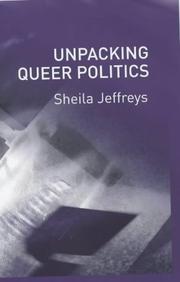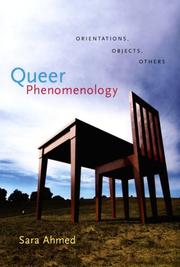| Listing 1 - 10 of 26 | << page >> |
Sort by
|

ISBN: 0745628370 Year: 2003 Publisher: Cambridge Oxford Malden Polity Press Blackwell Publishing Ltd.
Abstract | Keywords | Export | Availability | Bookmark
 Loading...
Loading...Choose an application
- Reference Manager
- EndNote
- RefWorks (Direct export to RefWorks)
Book
ISBN: 9780500480960 Year: 2024 Publisher: London : Thames & Hudson,
Abstract | Keywords | Export | Availability | Bookmark
 Loading...
Loading...Choose an application
- Reference Manager
- EndNote
- RefWorks (Direct export to RefWorks)
Drawing on one of the oldest and largest photography collections in the world, Calling the Shots offers an unprecedented view of photographic history through a queer lens. It includes a broad range of global LGBTQIA+ representation from the mid-nineteenth century to now, presenting images from pioneering LGBTQIA+ photographers and subjects alongside work documenting activism and hard-won legal battles, over a century of performance, nightlife, and diverse queer communities, collectives, and subcultures. Following an introductory essay by Zorian Clayton, images are presented in six thematic chapters: Icons, Staged, Body, Liberty, Making a Scene, and Beyond the Frame. Each chapter opens with a short introductory essay, followed by an extended plate section. Expanded captions highlight key images, and “artist in focus” inserts draw on the work of selected photographers to illuminate particularly rich moments in LGBTQIA+ history. Bold proclamations of queer identity and community sit alongside personal explorations of self; documentation of struggle, joy, and everyday life is considered side-by-side with performances and photographic fictions that continue to challenge the bounds of gender and sexuality. This vital, accessible volume offers an exciting, expansive appraisal of photography’s role in expressing, documenting, and celebrating queer life. It will be essential for all with an interest in the history of photography, but especially for those with an interest in LGBTQIA+ history.
Sexual minority community. --- Sexual minorities. --- Personnes queers --- Minorités sexuelles --- Histoire.
Book
ISBN: 9060016777 Year: 1981 Publisher: Deventer : Van Loghum Slaterus,
Abstract | Keywords | Export | Availability | Bookmark
 Loading...
Loading...Choose an application
- Reference Manager
- EndNote
- RefWorks (Direct export to RefWorks)
Fonds Suzan Daniel (FSD)
Homosexuality. --- #GBIB:IDGP --- Homosexuals --- Queers --- Gays --- Homosexuality, Ego-Dystonic --- Ego-Dystonic Homosexuality --- Gay --- Homosexual --- Homosexuality, Ego Dystonic --- Queer --- Homosexuality --- Sexual and Gender Minorities
Book
ISBN: 9023653807 Year: 1977 Publisher: 's-Gravenhage : Nijgh en Van Ditmar,
Abstract | Keywords | Export | Availability | Bookmark
 Loading...
Loading...Choose an application
- Reference Manager
- EndNote
- RefWorks (Direct export to RefWorks)
Sociology of the family. Sociology of sexuality --- Homosexuality. --- #gsdbP --- Homosexuals --- Queers --- Gays --- Homosexuality, Ego-Dystonic --- Ego-Dystonic Homosexuality --- Gay --- Homosexual --- Homosexuality, Ego Dystonic --- Queer --- Homosexuality --- Sexual and Gender Minorities --- Same-sex attraction --- Sexual orientation --- Bisexuality

ISBN: 9780822339144 0822339145 9780822338611 0822338610 0822388073 1283022346 9786613022349 Year: 2006 Publisher: Durham Duke university press
Abstract | Keywords | Export | Availability | Bookmark
 Loading...
Loading...Choose an application
- Reference Manager
- EndNote
- RefWorks (Direct export to RefWorks)
In this groundbreaking work, Sara Ahmed demonstrates how queer studies can put phenomenology to productive use. Focusing on the “orientation” aspect of “sexual orientation” and the “orient” in “orientalism,” Ahmed examines what it means for bodies to be situated in space and time. Bodies take shape as they move through the world directing themselves toward or away from objects and others. Being “orientated” means feeling at home, knowing where one stands, or having certain objects within reach. Orientations affect what is proximate to the body or what can be reached. A queer phenomenology, Ahmed contends, reveals how social relations are arranged spatially, how queerness disrupts and reorders these relations by not following the accepted paths, and how a politics of disorientation puts other objects within reach, those that might, at first glance, seem awry. Ahmed proposes that a queer phenomenology might investigate not only how the concept of orientation is informed by phenomenology but also the orientation of phenomenology itself. Thus she reflects on the significance of the objects that appear—and those that do not—as signs of orientation in classic phenomenological texts such as Husserl’s Ideas. In developing a queer model of orientations, she combines readings of phenomenological texts—by Husserl, Heidegger, Merleau-Ponty, and Fanon—with insights drawn from queer studies, feminist theory, critical race theory, Marxism, and psychoanalysis. Queer Phenomenology points queer theory in bold new directions.
Philosophical anthropology --- 82-993 --- Erotische literatuur --- Homosexuality --- Spatial behavior. --- Philosophy. --- fenomenologie --- Theatrical science --- 82-993 Erotische literatuur --- Homosexualité --- Comportement spatial --- Philosophie --- Homosexualité --- Spatial behavior --- Behavior, Spatial --- Proxemic behavior --- Space behavior --- Spatially-oriented behavior --- Psychology --- Space and time --- Philosophy --- homosexuality --- Filosofische antropologie --- Theaterwetenschap --- homoseksualiteit --- phenomenology --- Comportement spatial. --- Personnes queers. --- Philosophie. --- Butler, Judith --- Heidegger, Martin --- Freud, Sigmund --- Husserl, Edmund --- Merleau-Ponty, Maurice
Book
ISBN: 0434359025 Year: 1970 Publisher: London : Heinemann,
Abstract | Keywords | Export | Availability | Bookmark
 Loading...
Loading...Choose an application
- Reference Manager
- EndNote
- RefWorks (Direct export to RefWorks)
Homosexuality --- Homosexualité --- Homosexuality. --- 343.9 --- 613.8 --- -Same-sex attraction --- Sexual orientation --- Bisexuality --- Homosexuals --- Queers --- Gays --- Homosexuality, Ego-Dystonic --- Ego-Dystonic Homosexuality --- Gay --- Homosexual --- Homosexuality, Ego Dystonic --- Queer --- Criminologie --(algemeen) --- Geestelijke volksgezondheid. Alcohol. Drugs. Narcotica. Seksueel leven--(hygiëne en gezondheidszorg) --- -Criminologie --(algemeen) --- 343.9 Criminologie --(algemeen) --- -Homosexuality, Ego-Dystonic --- Same-sex attraction --- Homosexualité --- Sexual and Gender Minorities
Book
ISBN: 0824086929 9780824086923 Year: 1987 Volume: 313 Publisher: New York (N.Y.): Garland,
Abstract | Keywords | Export | Availability | Bookmark
 Loading...
Loading...Choose an application
- Reference Manager
- EndNote
- RefWorks (Direct export to RefWorks)
Homosexuality --- Bibliography --- Homosexuality. --- 616.89-008.442.36 --- 176.4 --- -Same-sex attraction --- Sexual orientation --- Bisexuality --- Homosexuals --- Queers --- Gays --- Homosexuality, Ego-Dystonic --- Ego-Dystonic Homosexuality --- Gay --- Homosexual --- Homosexuality, Ego Dystonic --- Queer --- Homoseksualiteit. Lesbianisme. Biseksualiteit --- Seksuele perversies --- -Homoseksualiteit. Lesbianisme. Biseksualiteit --- 176.4 Seksuele perversies --- -176.4 Seksuele perversies --- Same-sex attraction --- Sexual and Gender Minorities --- Homosexuality - Bibliography --- Homosexuality - abstracts
Book
ISBN: 063115275X Year: 1988 Publisher: Oxford Blackwell
Abstract | Keywords | Export | Availability | Bookmark
 Loading...
Loading...Choose an application
- Reference Manager
- EndNote
- RefWorks (Direct export to RefWorks)
Homosexuality. --- Homosexuality --- -176 --- Same-sex attraction --- Sexual orientation --- Bisexuality --- Homosexuals --- Queers --- Gays --- Homosexuality, Ego-Dystonic --- Ego-Dystonic Homosexuality --- Gay --- Homosexual --- Homosexuality, Ego Dystonic --- Queer --- Psychological aspects --- Seksuele ethiek. Seksuele moraal --- Psychological aspects. --- 176 Seksuele ethiek. Seksuele moraal --- Sexual and Gender Minorities --- -Psychological aspects
Book
ISBN: 1479864587 1479871842 1479881309 9781479881307 1479841315 9781479841318 9781479864584 9781479871841 Year: 2018 Publisher: New York
Abstract | Keywords | Export | Availability | Bookmark
 Loading...
Loading...Choose an application
- Reference Manager
- EndNote
- RefWorks (Direct export to RefWorks)
What was it like to live as a transgender person in a media environment before Caitlin Jenner, Orange Is the New Black, Transparent, and the current transgender reality TV boom? 'Struggling for Ordinary' answers this question by examining the role of media and technology in the everyday lives of transgender people before what some call the 'transgender tipping point' in popular culture.
Social media. --- Transgender people --- TG people --- TGs (Transgender people) --- Trans-identified people --- Trans people --- Transgender-identified people --- Transgendered people --- Transgenders --- Transpeople --- Persons --- User-generated media --- Communication --- User-generated content --- Social aspects. --- Transgender people - Social aspects --- Social media --- Identity. --- Media. --- Queer. --- comic. --- ethnography. --- ethnographys. --- gender-related. --- gender. --- gendered. --- queers. --- self-identity. --- transgendered.
Book
ISBN: 1479891673 1479848409 Year: 2020 Publisher: New York : New York University Press,
Abstract | Keywords | Export | Availability | Bookmark
 Loading...
Loading...Choose an application
- Reference Manager
- EndNote
- RefWorks (Direct export to RefWorks)
The first lesbian and queer historical geography of New York CityOver the past few decades, rapid gentrification in New York City has led to the disappearance of many lesbian and queer spaces, displacing some of the most marginalized members of the LGBTQ+ community. In A Queer New York, Jen Jack Gieseking highlights the historic significance of these spaces, mapping the political, economic, and geographic dispossession of an important, thriving community that once called certain New York neighborhoods home.Focusing on well-known neighborhoods like Greenwich Village, Park Slope, Bedford-Stuyvesant, and Crown Heights, Gieseking shows how lesbian and queer neighborhoods have folded under the capitalist influence of white, wealthy gentrifiers who have ultimately failed to make room for them. Nevertheless, they highlight the ways lesbian and queer communities have succeeded in carving out spaces—and lives—in a city that has consistently pushed its most vulnerable citizens away.Beautifully written, A Queer New York is an eye-opening account of how lesbians and queers have survived in the face of twenty-first century gentrification and urban development.
Sexual minorities --- History. --- Black geographies. --- Brooklyn. --- Constellations. --- Disidentifications. --- Feminist theory. --- Gentrification. --- Greenwich Village. --- Lesbian. --- Lines and orientations (Ahmed). --- Manhattan. --- Neighbourhood. --- Paradoxical space. --- People of color. --- Production of space. --- Queer failure. --- Queer theory. --- Queers of color. --- Racism. --- Transgender and gender non-conforming people. --- Urban geography. --- Whiteness.
| Listing 1 - 10 of 26 | << page >> |
Sort by
|

 Search
Search Feedback
Feedback About UniCat
About UniCat  Help
Help News
News